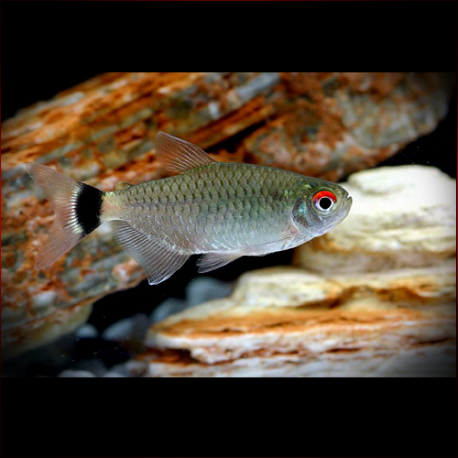More info
Datasheet
| Minimum Tank Size | 120 litres / 31.70 US gallons |
| Maximum Size | 7.6cm / 2.99inches |
| Temperament | Peaceful |
| Care Description | Easy |
| Temperature | 22.2°C / 71.96°F - 27.8°C / 82.04°F |
| Carbonate Hardness | 4-8 |
| pH | 5.8-8.5 |
General Description
The Red Eye Tetra, scientifically known as Moenkhausia sanctaefilomene, is a striking addition to larger freshwater community aquariums. Its elegant black and silver coloration is complemented by a vibrant red marking above each eye, creating a visually appealing display, especially when kept in a school of six or more individuals. This species boasts a natural tolerance to a wide range of water parameters, making it an excellent choice for various aquarium setups, including community tanks.
Aquarium Setup
Ideally, the aquarium housing Red Eye Tetras should include live plants, rocks, and driftwood to mimic their natural habitat and offer hiding spots. With a preference for groups, these relatively larger tetras thrive in a tank of 20 gallons or larger, appreciating ample swimming space. Additionally, it is essential to note that male Red Eye Tetras are typically smaller and slimmer compared to their female counterparts.
Behaviour
Known for their peaceful temperament, Red Eye Tetras are non-aggressive and coexist harmoniously with other fish species. They exhibit schooling behavior, so maintaining a group of these tetras is recommended to bring out their best characteristics and reduce stress.
Feeding and Diet
As omnivores, Red Eye Tetras in the wild primarily feed on small insects and planktonic organisms. However, in captivity, they readily accept frozen or freeze-dried foods like brine shrimp, daphnia, bloodworms, and tubifex, along with micro pellet and high-quality flake foods. Offering a varied diet ensures their nutritional needs are adequately met.
Reproduction & Dimorphism
In terms of reproduction, Red Eye Tetras are egg scatterers, with spawning typically occurring in densely planted tanks. During breeding, females may appear rounder due to egg development, while males tend to be smaller and thinner. Providing suitable conditions with plants for egg-laying and low lighting can encourage successful breeding in captivity.
Habitat and Distribution
The Red Eye Tetra, originating from South America, is commonly found in slow-moving tributaries, creeks, and rivers with abundant vegetation. Its natural habitat includes areas with soft, acidic water conditions, which should be considered when replicating their environment in an aquarium setup.

